Music streaming isn’t just a trend anymore — it’s a lifestyle.
From Spotify to Apple Music to niche regional players, audio platforms have evolved from passive jukeboxes to fully immersive entertainment ecosystems.
And in 2025, building a competitive music streaming app is less about the size of your library and more about the quality of your features.
In this guide, we’ll explore the must-have music app features for 2025, across core user experiences, AI integrations, admin & artist panels, and more.
Whether you're a startup founder, investor, or product owner, this blog will help you design a smarter product roadmap that delivers impact.
Why Music App Features Define Success in 2025?
Users no longer just want to “play music.” They want to feel connected, inspired, productive, and entertained.
The most successful music apps have focused on features that make discovery, personalization, and engagement effortless.
Take Spotify’s AI DJ for example — it combines voice AI, mood-based curation, and historical data to deliver a truly personal audio stream.
Apple Music’s integration with Fitness+ and Dolby Atmos offers immersive experiences beyond just songs.
Even regional players are betting big on interactive music app features like offline playback, real-time lyrics, and smart recommendations to win user loyalty.
If you want to create a music app that stands out, prioritize features. In 2025, it’s the features of a music app that will define whether users stick around — or switch to a competitor.
Core Features Every Music App Needs
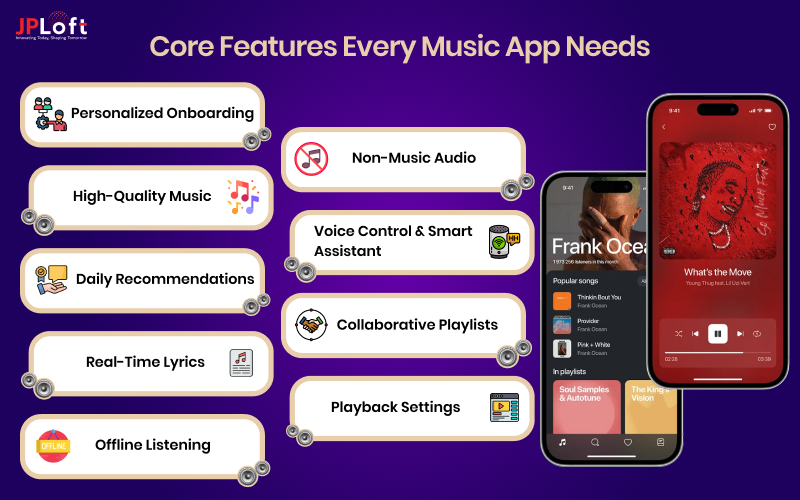
To meet modern user expectations, your app must offer a solid foundation of intuitive and impactful features.
These are non-negotiables in the music app ecosystem.
Below are the most essential music app features for startups and investors to prioritize in their MVP or full-scale product.
1. Personalized Onboarding & User Profiles
First impressions matter. A frictionless onboarding process paired with early personalization hooks helps users feel at home from the first tap.
Let users sign up quickly and provide enough inputs to tailor their experience instantly.
It’s also an early opportunity to begin collecting behavioral data that can be used for future recommendations, personalization, and monetization strategies.
-
- Social logins or OTP-based signups
- Onboarding questionnaire to gauge musical taste
- Dynamic profile with listening stats and preferences
2. High-Quality Music Streaming
Your app’s primary offering — the actual music — has to sound exceptional across different devices and networks.
Audio quality continues to be a deciding factor for users who listen with headphones, Bluetooth speakers, or high-end home setups.
For audiophiles, FLAC-level streaming has become essential - one of the key music app trends shaping listener expectations today.
Whether someone’s commuting with earbuds or hosting a party, you want to ensure a consistent, immersive listening experience.
-
- Support for 320kbps and FLAC-level streaming
- Adaptive bitrate based on network speed
- Bufferless playback with smart caching
3. Smart Playlists & Daily Recommendations
Music discovery is no longer just about algorithms; it’s about emotional context. Users want playlists that reflect their current mood, activity, or time of day.
Personalization engines can use user history, preferences, and listening patterns to build highly relevant suggestions that feel almost magical.
-
- "For You" mix based on recent activity
- Mood-based playlists (Focus, Chill, Workout)
- Integration with calendar/time-of-day routines
4. Real-Time Lyrics & Karaoke Mode
Lyrics features are a big draw, especially among Gen Z and millennial users.
Being able to sing along, follow along, or even perform karaoke directly within the app adds an element of interactivity that pure audio apps lack.
These interactive features of music apps entertain and help improve user retention and session time.
-
- Scroll-synced lyrics for every track
- Karaoke mode with scoring and vocal effects
- Shareable lyric screenshots
5. Offline Listening
Not every user has the luxury of streaming music 24/7 — especially in regions with spotty internet or data limitations.
By enabling offline listening, your app becomes reliable and accessible anytime, anywhere. It’s a powerful retention and premium feature that helps drive upgrades.
-
- Download entire playlists or albums.
- Manageable download limits for freemium users
- Auto-download favorite tracks for seamless listening
6. Podcasts & Non-Music Audio
Podcasts, audiobooks, guided meditations, and even short stories are now considered an essential feature of the modern music apps.
Integrating non-music audio gives your users more reasons to stay in your app instead of switching to a podcast-specific platform.
-
- Support for podcast episodes and channels
- Personal podcast playlists and categories
- Save/bookmark audio stories
7. Voice Control & Smart Assistant
As users juggle music apps with wearables, smartwatches, smart TVs, and smart speakers, voice control has become a must-have feature for music apps.
Including a voice assistant or supporting Alexa/Siri/Google Voice gives your app a futuristic, frictionless appeal.
-
- Play/pause/skip via voice commands.
- Request specific playlists or artists.
- Custom AI DJ that intros tracks and moods
8. Social Sharing & Collaborative Playlists
Music is inherently social. Users want to show off their favorite tracks, co-create playlists, and engage in shared music experiences.
Foster community—a must for startups aiming to start a music business with viral growth.
Features like collaborative playlists and sharing now-playing screens are great for virality and engagement.
-
- Share what you're listening to via Instagram, Snapchat, or WhatsApp
- Create joint playlists with friends or groups
- Show top-listened tracks by your followers
9. Playback Settings & Customization
Control is key to enhancing the user experience.
Power users expect granular controls — whether that’s tweaking the sound profile or adjusting how tracks flow.
Providing a range of customization options also makes your app more accessible to users with specific audio needs.
-
- Built-in equalizer for bass/treble tweaking
- Adjustable playback speed
- Sleep timer and autoplay toggles
Advanced Features That Set Your Music App Apart
In a saturated market, foundational features alone won't cut it.
The music apps leading the charge in 2025 are those that offer next-gen capabilities - combining AI, real-time engagement, and monetization tools to elevate user experiences.
These features not only improve user satisfaction but also boost retention and create new revenue channels.
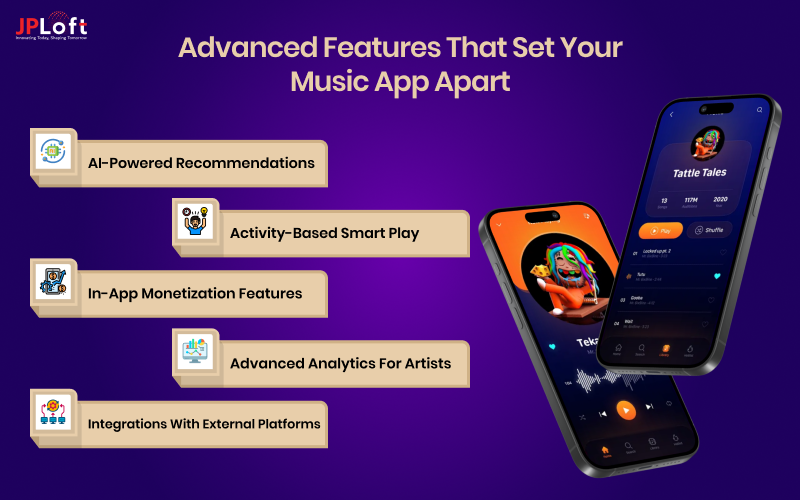
If you're building a music app to compete with the likes of Spotify or aiming to dominate a niche market, these advanced music app features are where the magic happens.
1. AI-Powered Recommendations & Auto-Curation
Modern users don’t want to scroll endlessly to find what they love.
AI in music apps now makes hyper-personalization mandatory - users expect smart recommendations from top-tier platforms.
AI-based recommendation engines analyze listening habits, skipped songs, playlist creation, and even device activity to suggest the perfect tracks at the perfect time.
-
- Hyper-personalized playlists generated by machine learning
- Predictive skip logic to avoid disliked tracks
- Real-time learning to refine recommendations with every session
2. Mood & Activity-Based Smart Play
Music is emotional, and your app should recognize that.
Advanced mood-detection features use AI and context (e.g., location, time, weather) to auto-play music that fits a user’s current vibe.
It’s a major engagement driver that can make users feel deeply understood.
-
- Smart playlists triggered by user behavior (e.g., gym time, evening walks)
- Mood selection via emojis or voice
- Adaptive audio streams for different environments
3. In-App Monetization Features
While subscriptions remain the core revenue model, these apps in 2025 are exploring more diversified music app monetization strategies.
From microtransactions to fan-tipping and exclusive content, the possibilities are evolving fast, especially for platforms that serve independent artists or influencers.
-
- Pay-to-unlock premium content (live recordings, artist drops)
- Digital tipping or donations for creators
- Ads based on user preferences or skipped content behavior
4. Advanced Analytics for Artists
Empowering artists with deep insights is a growing differentiator.
While apps like Spotify offers basic data, a dedicated dashboard within your app can offer even more — like location-based streaming stats, gender-based preferences, skip rates, and real-time listener counts.
This is especially important for platforms attracting and retaining emerging or indie artists.
-
- Live streaming metrics (e.g., plays, skips, completions)
- Audience segmentation by region, device, or playlist entry point
- Integration with artist marketing tools or email lists
5. Integrations with External Platforms
Your music app doesn’t need to operate in a silo.
In fact, integrating with fitness apps, calendars, social platforms, or smart home ecosystems can increase user engagement significantly.
Think of Apple Music’s sync with Apple Watch workouts, or how users control Spotify from their Peloton or Echo devices.
-
- Calendar-based playlists (e.g., Monday motivation mix)
- Sync with fitness apps for workout-specific tracks
- Trigger-based music playback via smart home automations
User, Admin & Artist Panels - And the Features They Need
To deliver a seamless and scalable music streaming experience, it's essential to break down the best music streaming app features across the three key stakeholders in your app: users, artists, and administrators.
Each group interacts with your platform differently, and overcoming music app challenges.
requires providing tailored tools for artists, users, and admins to succeed.
Below is a breakdown of features by panel:
|
User Panel Features |
Artist Panel Features |
Admin Panel Features |
|
Smart onboarding & music discovery |
Upload tracks & manage albums |
User & artist management |
|
AI-curated playlists & recommendations |
Real-time analytics & listener insights |
Content moderation & review tools |
|
Real-time lyrics & karaoke integration |
Fan engagement tools (comments, messages) |
Platform-wide analytics & usage reporting |
|
Offline mode & playback controls |
Revenue tracking & withdrawal options |
Monetization & payment settings |
|
Social sharing & collaborative playlists |
Schedule releases & live stream performances |
Feature toggles & push notification system |
|
Voice assistant compatibility |
Profile customization & social links |
Security, roles & permissions management |
Each panel supports the full music ecosystem — from creation to curation to consumption.
How to Choose the Right Music App Features for Your Project?
With so many feature possibilities, choosing the right set for your music streaming app can feel like navigating a maze.
Do you focus on AI-driven personalization or stick with tried-and-tested essentials? Should you prioritize audio quality, social discovery, or artist tools?
The truth is — your features should directly support your audience, business model, and growth phase.
Here are key considerations to help you make the right feature for music streaming apps in 2025:
1] Define Your Target Audience
Your user base should be the north star for every feature you include.
A Gen Z-centric music app will have vastly different needs compared to one tailored for working professionals or audiophiles.
Understanding your primary user personas helps filter out unnecessary features and sharpen your product vision.
-
- Gen Z: social sharing, collaborative playlists, karaoke, short-form audio
- Fitness-focused: wearable integration, BPM-based playlists, mood tracking
- Regional/vernacular markets: multilingual support, offline listening, local content
2] Start with a Lean MVP
Trying to build everything at once is a recipe for delays and bloated budgets.
Instead, launch with a Minimum Viable Product (MVP) that delivers core value — fast.
This helps you validate ideas, test market fit, and gather early user feedback to evolve your feature roadmap.
Consider that the cost to develop a music app scales with features - a well-planned MVP helps control budget while testing market fit.
-
- Must-haves: Onboarding, music streaming engine, search, user profiles
- Nice-to-haves: AI recommendations, offline downloads, lyrics sync
- Use modular architecture to expand features post-launch
3] Match Features with Monetization Strategy
Your monetization goals should directly influence the features you build. If you're planning a freemium model, you’ll need enticing paid-only features.
If you're going ad-supported, you’ll need detailed user analytics and ad-serving capabilities. If you're building for artists, creator tools and payout systems are essential.
-
- Subscription-based: Hi-fi audio, exclusive content, ad-free experience
- Ad-based: Banner/audio ads, segmentation tools, reward systems
- Creator-first: Track uploads, revenue dashboards, tipping features
4] Prioritize Personalization & AI from Day One
In 2025, personalized experiences are expected, not optional. The earlier you start collecting behavioral data, the better your recommendation engine will perform.
Even if AI features come later, building a framework for data collection and segmentation early is critical.
-
- Smart playlists based on time, activity, or weather
- Mood-based recommendations (focus, chill, energy)
- Listening to history and skipping behavior tracking
5] Don’t Overlook Security & Licensing Compliance
Features like offline listening, downloads, or content uploads bring legal and technical implications.
If you’re streaming copyrighted music, you’ll need to factor in DRM, content licenses, and reporting features.
Security measures and compliance must be baked into your architecture - not added later.
-
- Digital Rights Management (DRM) for premium content
- Geo-based content access and licensing filters
- Secure artist onboarding and content moderation
6] Evaluate Your Tech Capacity
Even the best product vision can be limited by in-house bandwidth or technical know-how.
Building advanced features for music streaming apps like real-time streaming, AI curation, or voice commands requires specific expertise.
Assess your team’s strengths honestly, and don’t hesitate to partner with a specialized mobile app development company.
-
- Real-time audio optimization for low-latency streaming
- Cloud infrastructure for auto-scaling as your user base grows
- Maintenance of third-party integrations like lyrics APIs or AI models
How Can JPLoft Help You Build a Feature-Rich Music App?
Dream of launching a feature-packed music app? Take the help of experts.
At JPLoft, we’ve helped startups, music labels, and media brands turn their app ideas into powerful digital products.
Whether you're building the next Spotify for a niche market or launching a localized podcast platform, as the best music app development company, we offer comprehensive services that cover:
-
- Feature strategy tailored to your goals and target users
- Pixel-perfect UI/UX design for users, artists, and admins
- AI integration for personalization, recommendations, and smart content delivery
- Scalable architecture using AWS, Azure, or custom cloud
- Monetization systems - subscriptions, ad SDKs, tipping, NFTs, and more
Let’s bring your vision to life. Schedule a free consultation to explore the ideal feature mix for your music app.
Conclusion: Build Smarter, Not Just Bigger
In 2025, music app success isn't defined by the number of songs- it’s shaped by the features that keep users coming back.
Your music streaming app features are your competitive edge, whether real-time lyrics, AI-powered playlists, collaborative listening, or immersive audio tech.
But building a feature-rich music streaming platform isn't just about checking boxes — it's about aligning technology, user needs, and business strategy.
Each decision you make can impact your product's long-term growth, from defining your MVP to scaling with personalization and monetization.
If you're a startup founder, investor, or enterprise looking to build or scale a music app like Spotify, Apple Music,
FAQs
In 2025, users expect more than just streaming. Essential music app features include high-quality audio playback, smart recommendations, real-time lyrics, offline listening, and personalized onboarding. Advanced features like AI-powered playlists, collaborative listening, and voice assistant integration are also becoming standard.
Start by identifying your target audience and monetization model. If you’re building for Gen Z, focus on social features and personalization. If targeting premium users, prioritize audio quality and offline access. Begin with a lean MVP and scale based on user feedback and analytics.
Music apps offer on-demand access to songs, personalized playlists, offline listening, and smart recommendations- enhancing convenience, discovery, and user engagement anytime, anywhere.
Yes. While subscriptions are a common revenue model, you can also monetize through ads, premium feature unlocks, artist promotion tools, or partnerships with content creators. Hybrid models like freemium access with paid upgrades are highly effective for scaling.
At JPLoft, we go beyond just coding. We bring strategic product thinking, real-world user insights, and deep technical expertise to every music app we build. From UI/UX to AI engines, we help you craft an app that not only works, but wins in the market.





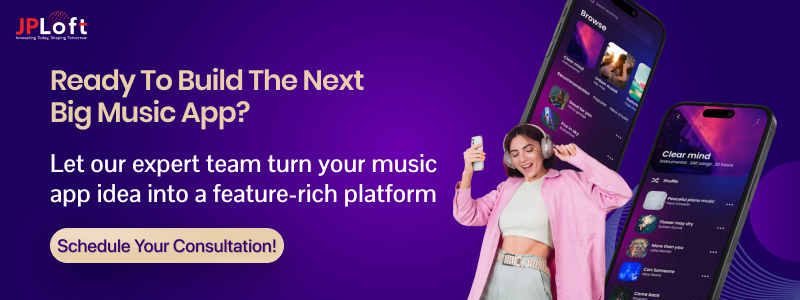
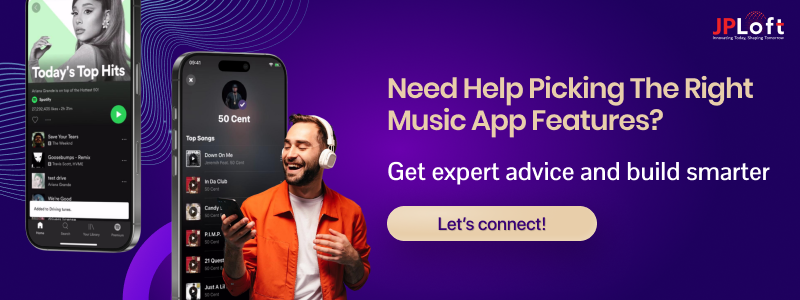

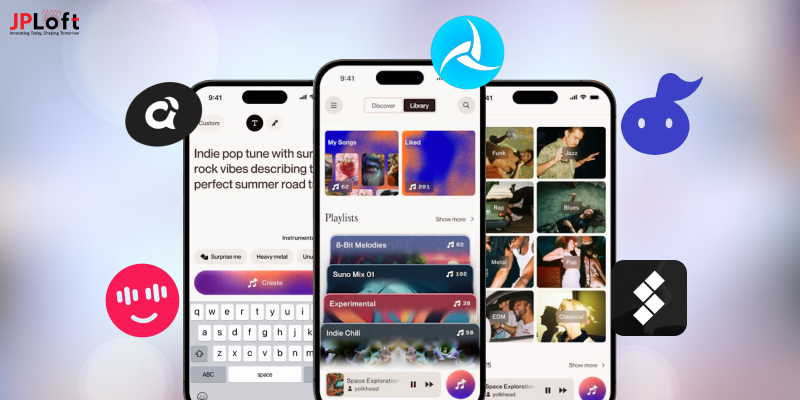
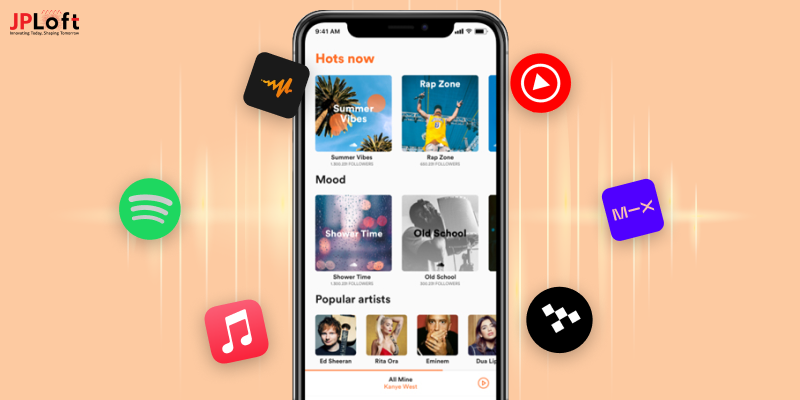
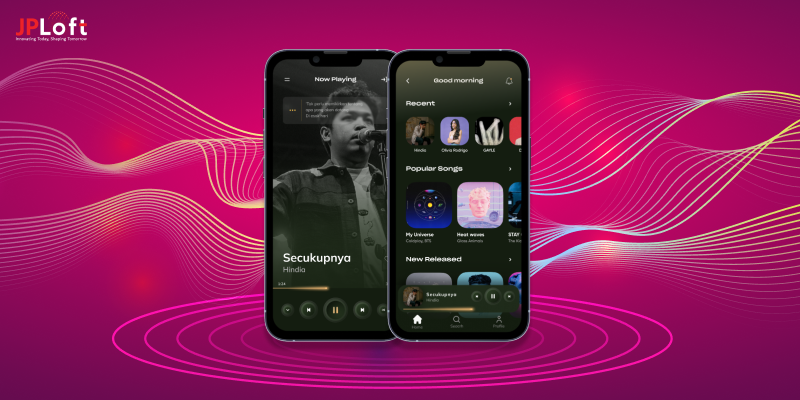



Share this blog